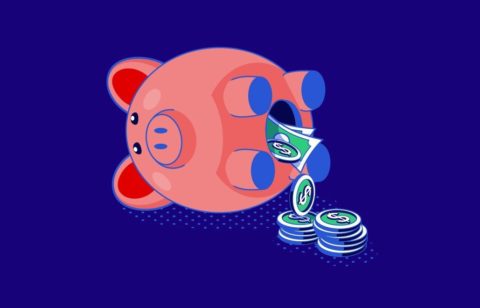
Household debt has been rising at a very steady rate over the last decade or so. As of the latest quarterly report by the New York Federal Reserve, household debt has not only surpassed the previous high mark of the Great Recession, but it’s expected to reach and possibly surpass an astronomical $13 trillion by the end of 2018. While mortgages make up the majority of household debt, credit card accounts represent the largest number of accounts, and that number is on the rise with no signs of slowing down. Even with the New York Federal Reserve inching up interest rates, which will have a significant effect on the amount of interest consumers will pay on their credit card accounts, new credit card debt is being accumulated at a rapid rate.
With the economy steaming along and the GDP over 4%, consumers haven’t felt this good about spending money in a long time. In fact, consumer confidence is at its highest mark in almost two decades. This is spurring consumers to spend their money not just on everyday purchases but also on big-ticket items such as second homes, expensive cars, vacations, and other luxury items. Wages are under pressure from a red-hot economy and a tight labor market, giving workers more leverage to demand higher rates of pay. Additionally, although America hasn’t seen significant wage growth lately, it’s believed that employers are simply opting more for bonuses rather than raising pay for their workers. This is likely due to increased profits coming into company coffers due to the current administration’s tax cut package that significantly lowered the corporate tax rate.
Also fueling the spending spree by American consumers is the fact that lenders are finally loosening their lending standards after taking a beating during the financial meltdown that began in 2007. In addition, American consumers who had their credit severely damaged during the Great Recession have now had sufficient time to repair their credit, and any bankruptcies, defaults, or foreclosures have subsequently dropped off their credit reports.
Another indication of the increase in consumer confidence is the significant increase in mortgage originations. Starting in 2016, the U.S. saw the largest increase in consumers taking out new mortgages since the Great Recession. The good news is that the household mortgage debt in America is largely current and doesn’t reflect the staggering delinquencies seen during the financial meltdown. However, while mortgages make up the majority of household debt, make no mistake about it: America is carrying plenty of other kinds of debt, including credit cards, auto loans, and massive amounts of student loan debt.
The question we should be asking ourselves as consumers in the U.S. is this: Why are we as Americans carrying so much debt? While the question is complex in many ways, we can examine a few obvious answers, as well as some not-so-obvious ones. Either way, consumers should be aware of the financial pitfalls that could potentially derail their financial security.
Why Do Americans Have so Much Debt?
There are quite a few reasons why Americans have so much debt. Some of it is self-inflicted, but much of it isn’t. Still, it’s important for consumers to understand the dynamics of a debt problem so they can guard against falling into a bad financial situation. A significant debt problem can happen very quickly under some circumstances. Only by understanding these potential circumstances can consumers take the necessary steps to lessen their risk. Here’s an in-depth look into several key reasons behind high consumer debt levels.
Living Above One’s Means
Pursuing the American Dream has always been a noble quest of the American citizen. However, what it means to achieve the American Dream means different things to different people. For many, the American Dream means having a family, buying a house with a white picket fence, and adopting a cute little dog, not necessarily in that order. For others, it means buying a second home, owning a luxury car, and taking lavish vacations. Whatever it means to each American consumer; for many, it means living above their means to “achieve” it.
Borrowing extensive amounts of money to own things you cannot afford is no way to get on the path to achieving the American Dream. Living a life in which you’re steeped in debt is not only contrary to the American Dream, but it’s downright miserable and more like a nightmare. The true essence of achieving the American Dream means working hard, sacrificing, and building financial wealth over time. It doesn’t mean going deep into debt to have it all right now.
One of the most dangerous things about credit cards is that they allow consumers to buy things they want, right now, whether they can afford them or not. With credit cards, it isn’t necessary to save for the things you want. Quite to the contrary, credit cards indulge the mentality of, “I want it now!”
With credit relatively easy to obtain now, consumers don’t need to build the disciplined habits of saving for the things they desire. Instead, they can just slide a card and have what they want, at the mere cost of their signature. It’s far too commonplace for consumers to buy it today and figure out how to pay for it later. To make matters worse, it’s estimated that over 70% of American consumers have multiple credit cards.
To avoid getting into a significant debt problem, consumers need to understand that living above one’s means by utilizing credit cards is a recipe for financial disaster. Practicing delayed gratification by saving and prioritizing the things they want and need is a far better plan for maintaining financial security.
A Lack of Savings
Americans are famous for being very poor savers. In fact, it was reported in an article by CNBC that a disturbing number of American consumers have very little savings. The article estimated that almost 70% of Americans have less than $1,000 in a savings account. The article also estimated that an alarming 34% of Americans have no savings at all!
When families have no savings to fall back on, they become very vulnerable to falling into debt when even the smallest of life’s emergencies hits. Something as small as a car repair or a broken appliance can start a cycle of utilizing credit cards to fill the gap between ordinary expenses and extraordinary expenses. If the unexpected life event is significant, such as the loss of a job or a large medical expense, a family can be plunged into a serious debt problem in very short order.
Most financial advisors agree that consumers need to have an emergency fund to secure their financial stability. Having a savings equal to several months of expenses is usually what’s recommended. Families must prioritize saving for emergencies.
While saving money isn’t easy, there are several ways to begin funding your emergency account. First, you should look to trim your everyday expenditures to create cash flow that can be directed to a savings account. You can do this in a number of ways, such as by reviewing your monthly bills and eliminating charges for services you aren’t using, trimming your spending on food by planning your meals, packing lunches and eating out less, and watching your entertainment dollars. These areas of spending represent some of the bigger opportunities for saving money within your budget.
You can also jumpstart your savings account with a few other tactics. You can begin by selling items you no longer want or need, by putting items on consignment at your local consignment shop, holding a garage sale, or selling items via online auction sites and selling platforms such as eBay and Etsy.
Having Poor Money Management Skills
Unfortunately, the skills of building a budget and managing money aren’t taught as part of the regular curriculum in most American schools. As a result, most consumers lack the ability to effectively manage their finances and build wealth. This leaves most to figure out how to manage their monthly finances on their own, while doing their best to save money for their retirement. This is a main reason why many Americans are dependent upon credit cards to make ends meet each month.
Those who lack basic money management skills can find much-needed help through online resources. Many websites offer free budgeting tools, which is a great place to start when trying to get a handle on your finances. Building a budget isn’t a hard task, but it does take a little time and effort. Primarily, it involves gathering and analyzing all your financial paperwork, such as your bank statements, credit card statements, bills, and pay stubs. By reviewing these documents, you’ll gain an understanding of where you’re spending your money and exactly how much money you have to work with each month.
Through budgeting, you’ll be able to find the areas where you’re bleeding cash and identify concrete ways to save your money. You’ll also determine exactly how much money you need each month to meet your obligations and have money left over for savings. In essence, it’ll help you balance your financial picture so you’ll be able to create a stable situation where you’re meeting your financial obligations and working to build wealth for the future.
Sometimes, it takes a combination of cutting expenses and increasing income to get to a healthy financial balance. You can increase your income by taking on a second job, increasing the hours you work at your current job, or starting a side business, for example. The bottom line is that you’ll need to stop overspending your income and find ways to put money away if you ever want to be in a position of financial stability.
Wages Not Keeping Up with the Cost of Living
The last decade saw a period of financial stagnancy. Not only was the economy not growing or thriving on a national level, but consumers were also feeling the pinch due to the prolonged period of nonexistent wage growth. With the GDP hovering below 3%, and their tax burden high, there was virtually no chance that employers could see their way clear to raise pay rates for their workers.
When wages don’t keep pace with the increasing cost of living, consumers find it harder and harder to keep up month after month. As the cost of living, in the form of housing costs, energy costs, food costs, etc. continues to rise, the gap between expenses and income gets larger and larger. In many cases, consumers will bridge the income gap by utilizing credit cards to pay for ordinary expenses.
This becomes an increasingly difficult situation for the consumer. As his or her credit card balances grow, so do the monthly payments that are necessary to stay current. Consequently, the gap between income and expenses continues to grow. The only way to stem the growing tide of insolvency is to increase income, decrease expenses, or both.
Losing a Job
It’s heartbreaking and devastating when the major breadwinner, or only breadwinner, in a family loses his or her job. The sudden impact can deal a significant blow to a family’s finances. If the loss of income is sudden and complete, the family may find itself in a critical situation very quickly. Just keeping food on the table and a roof over their heads may become an immediate struggle, and there may be very little assistance available. If there’s assistance available, such as unemployment compensation, it’s usually woefully inadequate.
When this happens, it’s common for a family to turn to credit cards as a way to survive. As they look to remedy the situation, they may have no other choice. Sometimes, the breadwinner may be forced to take a job at a lesser pay rate while he or she looks for a way to replace the lost income. This is what’s called being underemployed. Unfortunately, this was very prevalent during the years of the Great Recession. Many consumers racked up considerable credit card debt, and some are still struggling with it today. While the job market is much improved, consumers can still end up in this situation. This is why having a few months’ worth of expenses saved is a good idea.
Unexpected Medical Bills
The illness or injury of a family breadwinner can be financially devastating, especially if it keeps him or her out of work for an extended period. Just the high cost of medical care can be difficult to handle financially. When you add in lost wages, deductibles, prescriptions, and co-pays, the debt can build up fast.
Many times, families will need to turn to credit cards to pay for these expenses or to make ends meet and keep food on the table. Few situations have to the ability to derail a family’s finances like an unexpected illness or injury can.
Divorce
Unbelievably, the rate of divorce is actually coming down, recently reaching a 40-year low. It’s believed that this is because young people are waiting until later in life to get married, since studies show that those who choose to get married after the age of 25 tend to stay married longer. Even though the rate of divorce has actually been declining over the last few years, it’s still a very difficult situation for families to endure. Aside from the emotional aspects of a divorce, there are usually significant financial impacts as well.
As we all know, money plays a central role in any marriage, not only in its success but also in its failure. Couples who have fewer financial assets and who are at the lower end of the economic scale tend to have a higher rate of divorce. Moreover, those who have less education suffer a similar plight. Couples who’ve graduated college tend to stay married more often as compared to those without degrees.
Since money and economic status seem to play such critical roles in the success of a marriage, it also, conversely, plays a big role when a couple decides to divorce. Aside from matters surrounding the custody and visitation of children, money is the largest obstacle faced by couples trying to reach an agreeable settlement. Aside from figuring out the monetary aspects of caring for children, the cost of establishing two households can be crippling. If there isn’t enough income to cover all the additional cost, each party often turns to credit cards to fill the gap. Once again, this is how debt accumulates quickly, and it can be crippling over the long haul.
Do You Have a Significant Debt Problem?
Most people who have a troublesome debt problem will recognize some of the clear-cut signs. If you feel that some of the following instances apply to you, it may be time to consider consolidating your debt or taking other measures to resolve it.
- Your credit cards have all reached their limits
- You can only afford to make the minimum payments each month on your credit card accounts
- You don’t have enough income to meet all your monthly financial obligations
- Your credit score has decreased because your credit card balances are high, or because you’re missing payments
- You’ve had marital issues relating to your money problems
- If you have an unexpected expense and need to pay with a credit card
- You’re getting collection calls from creditors
- You need credit cards to pay for ordinary everyday expenses
- Your debt problem is making you feel hopeless about your financial future
Credit Card Consolidation as a Solution
Anyone who has a significant debt problem will eventually reach a point where he or she realizes something has to be done. The hope is that this point is reached before things become too serious and there’s still time to resolve the issue without resorting to default or bankruptcy.
If a consumer acts relatively quickly and well ahead of things getting too far behind, he or she will have the opportunity to consider several options. One of these options is debt consolidation. This involves consolidating all of one’s debt into a single loan with a single monthly payment to worry about, hopefully at a lower interest rate. There are a few types of debt consolidation loans for borrowers to evaluate.
Firstly, it’s important to understand the difference between secured and unsecured debt consolidation loans. An unsecured loan means you aren’t required to place any collateral up to secure the loan. Secured loans usually require an asset be placed as security, perhaps a piece of real estate, such as your home.
If you fail to make the payments on an unsecured loan, you’ll suffer significant damage to your credit rating. However, if you default on a secured loan, not only will your credit suffer, but you also could face a foreclosure and risk losing your property to the lender.
Pros and Cons of Debt Consolidation Loans
There are several reasons consumers look to debt consolidation loans to address their debt problems. The ease of only making one payment each month to one creditor eases the hassle of juggling debt, and it can help consumers feel more in control of their finances. If they’re consistently behind in paying their bills each month, a debt consolidation loan can give them a new start and a chance to build their credit score back up. Many times, the lower interest rate means that consumers are paying less each month to service their debt.
Debt consolidation can be a good option for many consumers, but it’s important to know the potential downsides. Perhaps the most important is that the consumer faces the reality of how he or she accumulated so much debt in the first place. If you got into debt because your income is unable to meet your expenses, then you run the risk of accumulating debt again. You’ll need to adjust your expenses, your income, or both.
Getting a debt consolidation loan can decrease the monthly outlay of cash you’re putting towards servicing your credit card debt. It’s important, though, that you make sure that the surplus of cash created isn’t absorbed into your everyday spending or you could find yourself in a cash shortfall again and relying upon credit cards to get by.
By making lifestyle changes and budgeting your money well, you can take important steps toward getting your debt paid off. However, continuing to overspend will result in just continuing your debt problem, even if you’ve gone through a debt consolidation process. If you don’t change your habits, you’re likely to end up in the same, or worse, debt problem.
However, if you’ve made a commitment to changing your ways with money, and you’ve decided that a debt consolidation is the right decision, you have several options to consider.
Different Types of Debt Consolidation Loans
Those who choose to consolidate their debt have a few options to think about, and determining the best choice will be dependent upon individual circumstances. However, it’s important to understand the differences in the types of loans available.
Refinancing Your Current Mortgage
One option that many consumers choose is refinancing their current mortgage and taking out some of their equity to pay off their debt. Generally, the lender doesn’t place any restrictions upon how cash or money is spent, so paying off debt is perfectly fine. In fact, some lenders will require that certain debts be paid off and the accounts closed.
If you do a good job in shopping around, you may be able to get a mortgage rate lower than what you’re already paying, which will help you with cash flow. This can seem very attractive to a borrower, but it’s important to consider the implications and risk of attaching debt to your home, which is, most likely, your most valuable asset.
The first thing you should consider is the fact that the bank will charge considerable closing costs to close your loan. You can either pay these costs out of pocket or roll them into the loan and finance them. Chances are strong that these closing costs will add up to several thousand dollars, so it could mean a big hit to your wallet, or add a substantial amount to your new mortgage. Remember, if you add the closing costs into the loan, then you’ll pay interest on the money for the life of the loan. That several thousand dollars could equate to several thousand more dollars just in interest.
The most important thing to consider is that if you attach your debt to your home, you’ll have moved your unsecured debt into a secured position. Additionally, that security is your home, which is your most valuable and important asset. If at any time you find yourself unable to afford your now larger mortgage, you could risk losing your home to foreclosure.
In addition, remember that it’s important to have made a commitment to avoid running up the balances on your credit cards again. If you do, you could find yourself in a worse situation than before you consolidated your debt.
Taking a Home Equity Line of Credit (HELOC)
Some consumers elect to take out a home equity line of credit. This mortgage loan allows the consumer to access the equity in the home for whatever purpose he or she chooses. It’s customary for the bank to approve the line of credit up to a certain amount, and the borrower can then draw upon the line as needed. The borrower can then pay back the loan at his or her own pace, as long as the interest accrued every month is paid.
Home equity loans are easy to obtain as long as the homeowner has a good amount of equity and decent credit, and the property being borrowed against is the primary home.
Since the funds from a HELOC are usually usable for any purpose, paying off debt is a suitable option. However, it’s important that borrowers understand that the same risks of borrowing against one’s home to pay off debt apply. Attaching the debt and increasing your debt obligation on your home could potentially put your home at risk should you ever be in a position where you’re unable to make the payments. It’s also important to consider the amount of interest you may pay over the life of the loan compared to just paying off your credit cards over a couple of years.
Again, it’s important to get your spending habits under control before doing any kind of debt consolidation, so you don’t run the risk of running up your debt all over again.
Taking Out Personal Loans
If you have good credit, you’re current on your payments, and you have a good relationship with your bank, you may be able to get an attractive rate and terms on a personal loan. Personal loans generally don’t require any type of collateral, as the bank lends the money based on merely the borrower’s signature. This is generally a good option for those who don’t have a very large amount of debt. This is because most banks or lending institutions will have a cap on the amount of money they’re willing to lend on a personal loan.
Many people opt for personal loans because they serve the purpose of streamlining the debt payoff process with one payment, and they can pay off their debt quickly and on a strict schedule. Personal loans usually carry much shorter loan terms than mortgage loans feature. This means that while your payments will probably be higher than with a mortgage loan, you’ll pay off your debt faster and accrue far less in interest.
Regardless of what path you choose to pay off your debt, it’s important that you act quickly once you realize you’re in trouble. The longer you choose to wait, the fewer options you’ll have. If you fall behind on your payments and damage you credit, your options will become very limited, very quickly.
If you find your debt problem spiraling out of control, don’t wait to act. Explore your debt resolution options and act before you’re facing insolvency, or worse!





